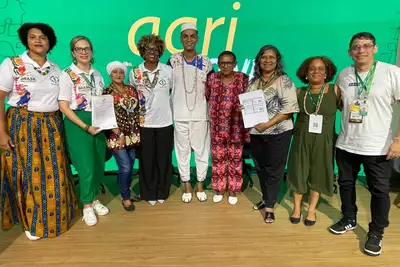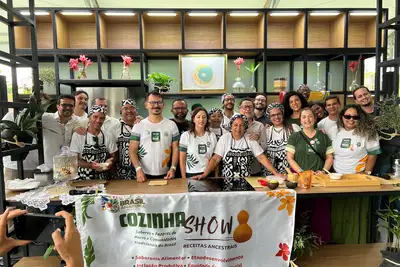Government of Pará's project reintroduces golden conures into the wild and marks a new chapter in the conservation of the species
In eight years, the Reintroduction and Monitoring Project has already returned 58 birds to the wild, and another seven were born in Pará, resulting from natural reproduction, reinforcing the presence of the species in the skies of the capital of Pará.

Spotting the vibrant yellow of golden conures (Guaruba guarouba) in the skies of the Metropolitan Region of Belém was, until a few years ago, a distant memory. The species, considered extinct in the area, had disappeared from its natural habitat, a victim of deforestation, animal trafficking, and the destruction of nesting areas. Today, however, the reality has changed. Thanks to the efforts of the government of Pará, through the Forest Development and Biodiversity Institute (Ideflor-Bio), in partnership with the Lymington Foundation, the presence of the bird symbol of Brazil is once again coloring the capital of Pará.
This Monday (17), at 7:30 AM, the project gains another chapter, with the release of the first 15 of the 30 golden conures that are part of the actions related to COP30. The activity will take place at the aviary of the Utinga State Park. In eight years, the Reintroduction and Monitoring Project has already returned 58 birds to the wild, and another seven were born in Pará, resulting from natural reproduction, reinforcing the presence of the species in the skies of the capital of Pará.
The number represents a historic milestone for the conservation of the species and reignites the pride of residents as they encounter the golden conures free once again, after decades absent from the urban landscape. Many of these birds were born at the Lymington Foundation in Juquitiba (SP), where they receive veterinary care, balanced nutrition, and behavioral stimuli necessary for their full development.

The arrival of the golden conures in Pará opens the most delicate phase of the process: acclimatization. For four to six months, the birds remain in a special aviary installed in the Utinga Camillo Vianna State Park in Belém, where they undergo health evaluations, socialization, and training that will prepare them to face the challenges of life in the wild. Their diet also changes: Amazonian fruits, such as açaí, murici, and uxi, are offered so that the animals recognize typical foods from their habitat.
Success - Until recently, the reintroduction of the golden conure was considered a distant goal. Today, there is an entire generation of birds that have already been born in Pará after the release of the first breeding pairs. "The success of this work shows that it is possible to recover threatened populations when there is science, commitment, and a union of efforts," says the president of Ideflor-Bio, Nilson Pinto. "The golden conures have come back to stay, and each flight represents a victory for conservation," he adds.
With good results accumulated, the project began its third phase in 2024. In April, Ideflor-Bio and the Lymington Foundation signed a Collaboration Agreement that expanded the structure at the Utinga State Park, with the expansion of the training aviary, new environmental education spaces, and the installation of an interactive digital equipment to bring the population closer to the preservation work. The goal now is even more ambitious: to release 30 new individuals during the 30th United Nations Climate Change Conference (COP30), which will take place from November 10 to 21 in Belém.

Respect for wildlife - For the Biodiversity Manager of Ideflor-Bio, Mônica Furtado, the project symbolizes Pará's commitment to the conservation of Amazonian fauna at a crucial moment for the global environmental agenda. "The reintroduction of the golden conures is a historic legal milestone for our State and for the city of Belém. In the year we host COP30, we will have the symbolic act of releasing 30 individuals into the skies of the capital," she explains. According to Furtado, the return of the species is so successful that there are already records of natural reproduction in the region. "During the execution of the project, seven chicks have already been born in the forest of the Metropolitan Region. They are the 'belém golden conures', a living symbol that the work has succeeded," she emphasizes.
The routine of preparing the birds involves native feeding, physical strengthening, socialization, and environmental recognition. The biologist from the Lymington Foundation, Marcelo Vilarta, monitors each stage. "The acclimatization process consists of training the birds for life in the wild. They learn to forage for food in the forest, to fly long distances, and to identify potential predators. This training is essential because they are born in captivity and need to acquire natural instincts," he explains.
According to him, group behavioral development is decisive. "Golden conures form family groups. While part of the group feeds, others act as sentinels. In reproduction, even individuals that are not breeding help feed the chicks," assures the specialist.

Permanent monitoring - Even with the achievements, Vilarta emphasizes that the challenge continues. The species still faces risks and depends on permanent care to avoid disappearing again. "It is a great satisfaction to participate in a project of this magnitude, especially representing Pará at COP30. But we cannot relax: any change in the environment can interrupt reproduction processes and compromise the survival of the group," he warns. Despite this, the team remains optimistic about the stabilization of the population, which is already beginning to increase naturally - a clear sign that the environment has become favorable again.
The symbolism of the golden conure goes beyond the beauty of its golden-yellow and green feathers. The bird represents ecological balance: it disperses seeds, integrates ecological chains, and is an indicator of the environmental health of the forest. Its return to the skies of Pará also carries cultural significance, as the species is considered a national symbol and part of the Amazonian imagination. "When a species returns, biodiversity breathes," emphasizes Mônica. "Conserved forest, alive and beautiful fauna," she adds.
If before the golden conure was restricted to aviaries and scientific books, now it is once again free, amidst the forest. "Pará writes an inspiring chapter for Brazil and the world: that restoring and protecting is possible - and that each wingbeat represents a more vibrant, greener, and more Amazonian future," concludes the president of Ideflor-Bio, Nilson Pinto.














